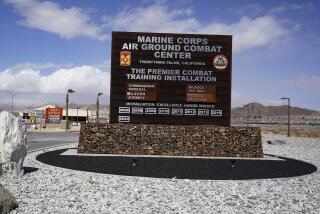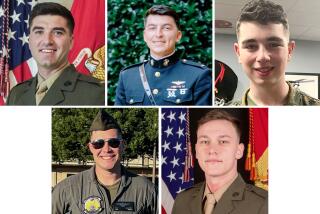Military Police Target Auto Safety Violations
- Share via
Packing a 9-millimeter handgun, the grim-faced soldier in the bulletproof vest eyed the line of cars and trucks entering the Miramar Marine Corps Air Station. Squinting in the bright morning sun, Cpl. Benjamin Davis inspected each identification card closely, scanned inside each car and scrutinized every driver.
Davis, a military police officer, takes his job seriously. He is, after all, the first line of defense against a slew of potential threats: terrorists, thieves, spies and seat belt scofflaws.
Yes, seat belt scofflaws.
Responding to a jump in traffic deaths in the military, America’s fighting forces launched a campaign last month to crack down on seat belt use and other automobile safety issues. For good reason. Since the Vietnam War, more men and women in uniform have been killed in auto accidents than in training and combat combined.
In the last five years, the military has lost an average of about 260 men and women annually to traffic accidents. By comparison, 148 American soldiers were killed in combat during the Persian Gulf War, a military operation that involved more than 660,000 American servicemen and servicewomen.
Traditionally, military personnel have had a slightly lower automobile accident rate and a higher rate of seat belt use than the civilian public, on and off base.
But that may be changing. From October 2001 to September, 321 uniformed men and women died in traffic crashes, up 35% from the previous year. Nearly half of those killed were not wearing seat belts, according to the Department of Defense.
The disturbing increase prompted the four branches of the armed services to ally with the National Safety Council to combat low seat belt use in the military.
“In the military, every fatality is like a death in the family,” said Chuck Hurley, vice president of the traffic safety group for the National Safety Council.
But the problem is not just seat belt use. It includes a range of risky behind-the-wheel behavior, including speeding and drunk driving.
On military bases, traffic laws are strictly enforced and violators can lose driving privileges or face extra duties, such as kitchen patrol.
Off base is another story. Young soldiers trained to endure pain, to fear no enemy, can forget that they are mortal and vulnerable to injury. Too often, they knock back a few beers, get dogfaced and speed around town, imagining they are Tom Cruise in “Top Gun.”
The problem is particularly acute in the Marine Corps. From October 2001 to September, 46 leathernecks died in auto crashes, compared with 25 deaths the previous year. Well over half of those killed were not wearing seat belts, and 20% of the deaths involved alcohol, military officials said.
Lt. Col. Benjamin Moody of the Marine Corps’ safety division points out that the Marines are an elite fighting force and cannot afford to lose a few good men.
“We feel those losses more than anyone else,” he said.
Why Marines? One reason could be that nearly 70% of Marines are between the ages of 18 and 26 -- a higher percentage than in the other military branches. It is an age group known for high-risk driving and low seat belt use.
The Marine culture also may play a role.
“There is definitely a mentality that I’m invincible. I’m a Marine,” said Capt. Scott Hornbuckle, a safety officer at the Miramar Marine base.
Moody agreed. “Part of our training instills in Marines the attitude that, ‘I can take any pillbox. I can take any hill. Whatever it is, I can do it,’ ” he said.
In February, a private first class was killed in the Bay Area when she fell asleep behind the wheel, crashed and was ejected from her car. She was not wearing a seat belt.
That same month, two lance corporals from the Marine Corps Air Station in Yuma, Ariz., were in a car, trying to overtake another vehicle at 80 mph. The driver lost control and flipped the car. The driver, who was not wearing a seat belt, was thrown free and killed. The other Marine, who was wearing a seat belt, survived.
On military bases, the Marines are dead serious about enforcing seat belt use. Anyone caught driving without a seat belt is cited.
In the past, Marines who were cited were dinged four points on their driving record. If a Marine gets 12 points or more during a 12-month period, that Marine can lose driving privileges on the base for up to a year.
Since the recent crackdown began, every seat belt violation also requires that the soldier visit a military traffic court, where a high-ranking officer can impose additional penalties.
The California Highway Patrol is doing its part too. CHP officers near the Marine bases at Twentynine Palms and Camp Pendleton are now notifying the base commanders whenever a Marine is cited off base for driving without a seat belt. The CHP hopes to expand this program to other bases in the state.
Given the mounting toll, Marine officials are making sure the message carries like a rifle shot.
On a recent morning at the main gate of the Miramar Marine Corps Air Station, Cpl. Anthony Cruz, a military police officer, stood on the median of the road, aiming a radar gun at traffic leaving the base.
A baby-faced soldier driving out of the base in a gray Nissan slowed as he approached the corporal, then began to speed off when it seemed he had cleared the radar gun’s scope.
“Stop!” commanded Cruz, a brawny Marine with a no-nonsense expression.
The stunned driver, who wasn’t wearing a seat belt, stopped next to Cruz, who then ordered the young GI to pull to the curb.
After issuing a citation, Cruz returned to his post. He said the driver’s excuse for failing to wear his seat belt was a common one: He forgot.
He probably won’t forget again.
*
If you have a gripe, story idea or question about driving in Southern California, send an e-mail to behindthewheel@latimes.com.
More to Read
Sign up for Essential California
The most important California stories and recommendations in your inbox every morning.
You may occasionally receive promotional content from the Los Angeles Times.














